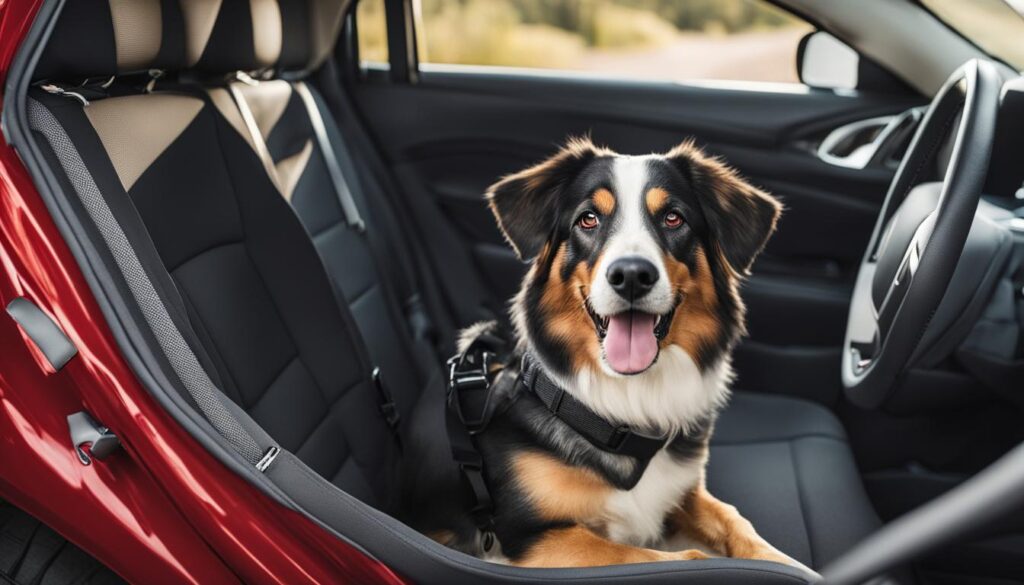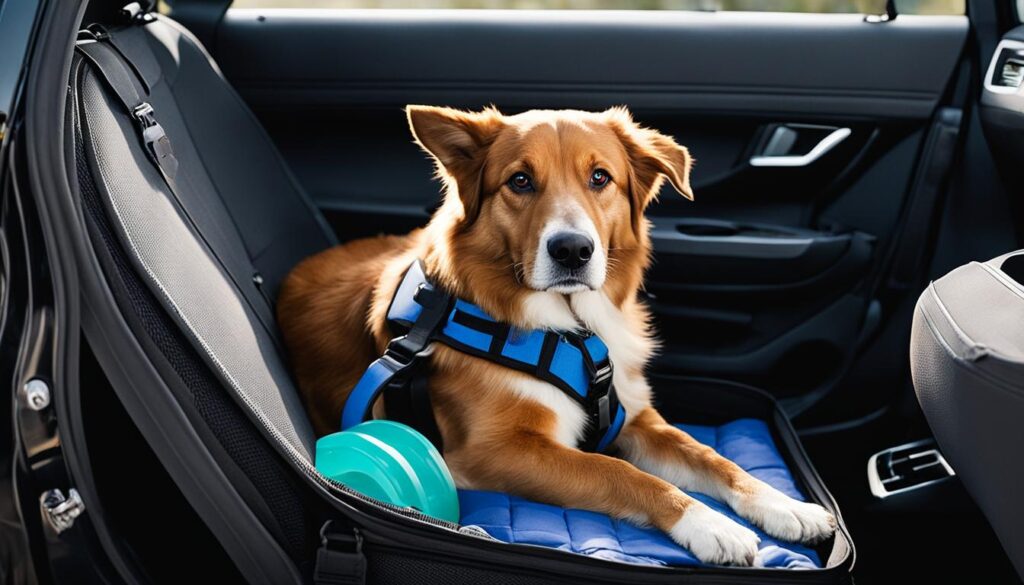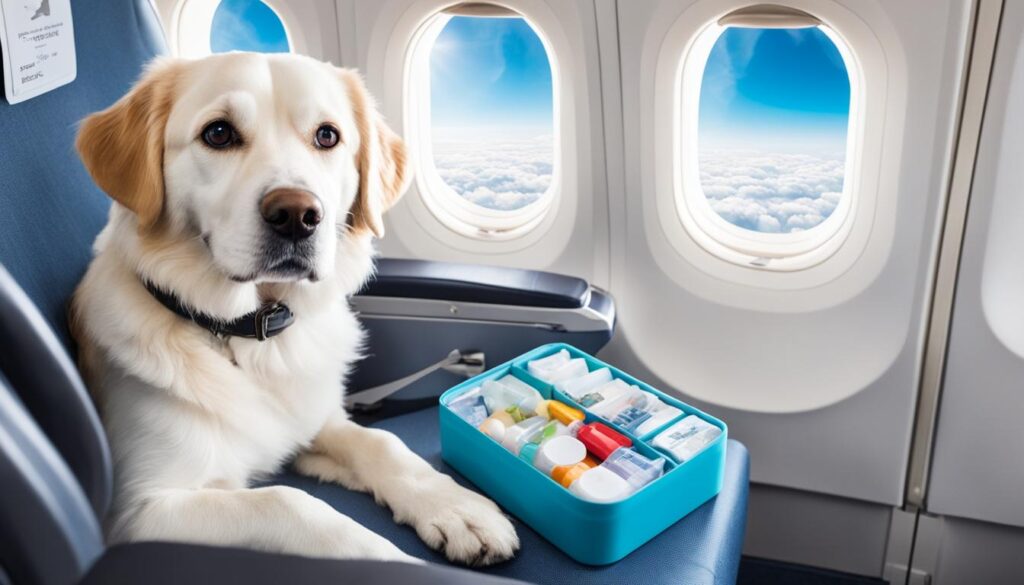If you’re planning a trip and want to bring your senior pets along, there are a few things you should know to ensure a smooth and comfortable journey for your furry friends. Traveling with senior pets can be challenging, but with these essential tips and expert advice, you can make the trip an enjoyable adventure for both you and your pets.
In this section, we’ll cover everything you need to know, from preparing for the journey to choosing the right mode of transportation, to safety measures and managing health needs. Traveling with your aging companions can be an unforgettable experience, so let’s get started with some senior pet travel tips.
Preparing for the Journey
Before embarking on your trip, it’s important to prioritize your senior pet’s comfort and safety.
Scheduling a pre-travel vet visit is essential to ensure that your pet is healthy and able to withstand the journey. Your vet can also advise you on any necessary vaccinations or medications to safeguard your pet during travel. Don’t forget to pack enough of your pet’s medication to last the entire trip, plus a little extra just in case.
Packing essential supplies such as food, treats, water, bowls, and bedding will keep your pet comfortable and feeling at home. Carrying toys and familiar items can reduce anxiety and provide comfort to your aging companion.
Ensuring your accommodations are pet-friendly and suitable for elderly animals is crucial in ensuring a smooth journey. Research prior to making a reservation, ensures that you won’t be charged for unexpected fees or extras. Make sure to inquire about any specific senior pet amenities, like pet stairs, so your pet can easily jump on a bed, and ramps, allowing your pet to climb stairs.
By taking necessary precautions and planning appropriately, you can ensure your senior pet is comfortable and safe throughout your trip.
Choosing the Right Mode of Transportation
When it comes to traveling with senior pets, choosing the right mode of transportation is crucial for their comfort and safety. Let’s take a closer look at the different options available:
| Name of Transportation | Pros | Cons |
|---|---|---|
| Road trips |
|
|
| Air travel |
|
|
| Train journeys |
|
|
Based on the pros and cons presented, you can weigh the options and decide which mode of transportation is best for you and your senior pet. Keep in mind that regardless of which mode of transportation you choose, there are certain best practices that you should follow:
- Make sure your pet is comfortable and secure when traveling
- Bring necessary supplies, such as food, medications, and bedding
- Plan for rest stops to allow your pet to stretch their legs and use the bathroom
- Consult with your veterinarian prior to traveling to ensure your pet is healthy enough for the trip and that you have everything you need
Remember, traveling with senior pets requires extra attention and care, but with proper planning, you and your pet can enjoy memorable and safe adventures together.
Safety Measures for Traveling with Senior Pets
If you’re planning a trip with your elderly furry friend, their health and safety are your top priorities. Here are some senior pet travel safety tips to consider:
Secure Your Pet Properly During Car Rides
Use a pet travel carrier or a seat belt designed for pets to secure your companion and keep them safe during car rides. Make sure the carrier or seat belt is the appropriate size for your pet and properly secured in the car.
Provide Identification Tags
Make sure your pet has an up-to-date and visible identification tag that includes their name, your phone number, and any vital medical information. This will help quickly reunite you with your pet if they become lost during travel.
Avoid Common Travel Hazards
Senior pets have unique needs and may be more prone to certain travel hazards. Keep your pet safe by avoiding extreme temperatures, ensuring they have access to clean water and enough food, and keeping them away from unfamiliar pets or dangerous wildlife.
Traveling with Older Cats and Dogs
If you’re traveling with an older cat or dog, consider their age-related needs. Provide comfortable bedding and ensure they have access to their favorite toys. Administer any medications as directed by your veterinarian and bring along any necessary medical supplies.
By taking the necessary precautions and following these tips for traveling with older cats and dogs, you can enjoy a safe and enjoyable trip with your loyal companion.
Managing Medications and Health Needs
Traveling with geriatric pets can be challenging, especially if they have specific health needs or require regular medication. To ensure a safe and comfortable trip for your furry friend, it’s important to make necessary preparations and follow these expert tips on managing your pet’s medications and health needs:
Schedule a Pre-Travel Vet Visit
Prior to your trip, it’s crucial to schedule a pre-travel vet visit with your senior pet’s veterinarian. This will ensure that your pet is up-to-date on all necessary vaccinations and prescriptions, and that any potential health concerns are addressed beforehand. Be sure to bring a copy of your pet’s medical records with you, as well as contact information for the veterinarian at your destination.
Pack Medicine and Supplies
When packing for your trip, be sure to bring all necessary medications and supplies for your senior pet. This may include prescription medications, supplements, and any medical devices or equipment your pet may need. It’s also a good idea to bring a first aid kit specifically for your pet, as well as extra food, water, and familiar treats to help them feel more comfortable.
Create a Medication Schedule
While on the road, it can be easy to forget when to administer your pet’s medication. To avoid any missed doses or accidental overdoses, create a medication schedule and stick to it throughout your trip. You can use a reminder app or set alarms on your phone to help you remember when it’s time to give your pet their medication.
Keep Your Pet Comfortable and Safe
While traveling, it’s important to keep your geriatric pet comfortable and safe. This may involve providing them with a comfortable pet carrier or travel crate, as well as soft bedding and toys to keep them entertained. Be sure to secure your pet properly during car rides and keep them away from potential hazards such as open windows or hot surfaces.
Expert tip: “Always bring sufficient medication refills and a copy of your pet’s prescription, just in case of unexpected delays or emergencies. It’s better to be prepared and have peace of mind than to worry about running out of medication while on the road.” – Dr. Sarah Smith, DVM
Keeping Your Senior Pet Comfortable on the Road
Travelling with senior pets in cars requires special attention to their comfort. Long car journeys can be particularly challenging for aging pets, particularly those with mobility issues or chronic illnesses. Here are some tips to help you keep your elderly companion comfortable and happy on the road:
- Select the Right Travel Crate or Carrier: For small pets, choose a carrier that allows them to stand, turn, and lie down comfortably. For larger pets, select a crate that provides plenty of room to stretch out. Ensure the crate or carrier is well-ventilated, secure, and stable in the car.
- Plan Regular Breaks: Stop every 2-3 hours to stretch your pet’s legs, offer them water and food, and allow them to relieve themselves. Use a leash or carrier to keep your pet secure at rest stops.
- Provide Appropriate Bedding: Bring your pet’s favorite blanket or bed to provide a sense of familiarity and comfort. Use a waterproof liner or absorbent pad to prevent any accidents from soiling the car and bedding.
- Bring Familiar Toys: Bring a few of your pet’s favorite toys to provide them with mental stimulation and comfort during the journey. Squeaky toys, chew toys, and puzzle toys can help alleviate boredom and reduce stress.
By following these tips, you can help prevent discomfort, anxiety, and stress for your senior pet while traveling. Remember to prioritize their safety and well-being throughout the journey.

Exercising and Stretching During Travel
Traveling with senior pets doesn’t mean that exercise and stretching routines should be compromised. In fact, these activities are still vital in keeping your furry friends mentally stimulated and physically healthy even while on the road. Here are some senior pet travel tips for incorporating exercise and stretching into your travel itinerary:
Create Opportunities for Exercise
Plan frequent stops during road trips in pet-friendly parks or open areas, where your furry friend can stretch their legs and even play fetch. If you’re flying, ensure your pet stretches their legs at the airport pet relief area or take a walk before boarding. It’s essential to prioritize your pet’s comfort and safety while exercising, so consider their physical and environmental needs.
Incorporate Stretching Routines
Stretching is a great way for senior pets to cultivate flexibility and reduce stiffness during travel. Simple stretches like hip rotations, neck stretches and spine twists can be done in your accommodation or during rest stops. It’s crucial to ensure that you only do stretches that are safe and appropriate for your pet’s physical capabilities. You can consult your vet for guidance on the ideal stretching routine or check with senior pet groups for tips.
Provide Mental Stimulation
Keeping your senior pet’s mind engaged during travel is vital to relieve boredom and anxiety. You can bring their favorite toys or introduce new puzzle toys to keep them mentally stimulated. You can even try scent games or hide-and-go-seek for some fun mental stimulation.
Tips: Ensure to pack enough food, treats, and water for your senior pets during travel and provide opportunities for them to relieve themselves frequently.
Adjusting to New Environments
Traveling with senior pets often involves visiting new places and environments, which can be overwhelming for them. To help your pet adjust quickly and comfortably to new surroundings, follow these senior pet travel tips:
Create a Familiar Space
As soon as you arrive in your new destination, set up your senior pet’s bed, food, water bowls, and litter box (if applicable) in a familiar area. Use items from home such as blankets, toys, and bedding to create a sense of familiarity and comfort.
Maintain Daily Routines
Keep your pet’s daily routine as consistent as possible, including feeding times, potty routines, and exercise schedules. Consistency can help your senior pet feel more secure and at ease in their new environment.
Introduce New People and Animals Slowly
While it’s important for your senior pet to socialize, it’s best to introduce them to new people and animals gradually and in a controlled manner. Give your pet time to adjust and explore their new environment at their own pace, and be sure to supervise any introductions to avoid overwhelming them.
“Adjusting to a new environment can be difficult for any pet, but especially for senior pets. By following these simple tips, you can make the transition as smooth and stress-free as possible for your aging companion.”
Conclusion
Traveling with your senior pet can be a rewarding experience, but it requires careful planning and attention to their specific needs. Remember to prioritize their comfort, health, and safety throughout the journey, and enjoy creating lasting memories together.
By following the essential tips and expert advice provided in this article, you can ensure safe and stress-free adventures with your aging companion. Take the time to prepare your pet for the journey, choose the right mode of transportation, and implement important safety measures.
Don’t forget to manage your pet’s medications and health needs, and keep them comfortable and stress-free during long car rides. Incorporate exercise and stretching routines into your travel itinerary, and help your pet acclimate to new environments.
With these tips in mind, you and your senior pet can embark on unforgettable adventures together, wherever your travels may take you.
















































